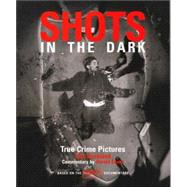
Note: Supplemental materials are not guaranteed with Rental or Used book purchases.
Purchase Benefits
What is included with this book?
The New copy of this book will include any supplemental materials advertised. Please check the title of the book to determine if it should include any access cards, study guides, lab manuals, CDs, etc.
The Used, Rental and eBook copies of this book are not guaranteed to include any supplemental materials. Typically, only the book itself is included. This is true even if the title states it includes any access cards, study guides, lab manuals, CDs, etc.
Excerpt
Crime Scenes
Our responses to violence are as complex as the subject itself. Many respond to violence with a mixture of horror, revulsion, outrage, fascination, arousal, and valorization.
-James Gilligan, Violence: Our Deadly Epidemic and Its Causes
We are all wildly ambivalent about crime photography. We want to look, and we want to look away. Our response to many images of violence is the same as it is to a terrifying scene in a movie: we cover our eyes but leave our fingers just a little apart. The police photographer has no option; he must take his regulation overviews and close-ups. The newspaper photographer and the TV cameraman have more latitude with camera angles and subject matter. We, the conflicted public, expect them there, at the scene of the crime, as our surrogate observers.
The ancients and Shakespeare believed in the power of tragedy to reveal truth; in the later part of the nineteenth century, people started to trust the power of the new medium of photography. "The nineteenth century," writes William Ivins, Jr., in Prints and Visual Communications, "began by believing that what was reasonable was true and... would end up by believing that what it saw a photograph of was true." Today, fact and fiction collide in photographs, and often it is hard to know what is real and what is not.
The photographs in this chapter are from real crime scenes--unmediated, with an ugly, uncensored face. Pleasant pictures are easier to look at, of course, but perhaps Freud was right: we must face our demons as well as our deities. We look at landscape photography and lose ourselves in another place. We view historical images and arrive at a deeper understanding of the past. In portraits, we see men and women whose accomplishments we admire or detest, or who simply are our neighbors here on earth. We look at photojournalism to be informed, intellectually and emotionally, about people around the world--and too often, about their plight. Beautiful photographs exist to give sensual pleasure, while snapshots are taken, for the most part, to provide fond memories later. We have no road map, no background, for viewing many of the photographs in this chapter.
We come upon them alone. We bring our own personal history, our fears and fascinations. "Don't look," our mothers told us if there was something brutish in the world, "you will have bad dreams." I have had more nightmares about accidentally or intentionally murdering someone than I have had about being the corpse on the ground. I look at the victims in some photographs for cold comfort: they reassure me that I could never do that to another human being. In his article "The Pornography of Death" (published in 1955 and quoted in Barbara Norfleet's Looking at Death), Geoffrey Gorer concluded that death had replaced sex as the taboo subject in Western society. Even pornography may elicit a communal giggle; we feel more guilt looking at death than we do looking at forbidden flesh.
The world, however, does not become a kinder, gentler place because we hide what is not kind and gentle. The crime scene pictures here have been brought out of the closet and into our consciousness. These are difficult to look at because they demand so much of the viewer. And as with death itself, we must face the significance of these images alone. Police pictures are pure evidence, and in their starkness we recoil. Photographs by Weegee, Stephen Shames, Donna Ferrato, Andrew Savulich, Alex Tehrani, and Mark Peterson, although oppressive, are easier to reconcile because they have been filtered through another person's sensibility and art.
Death is a member of the family, the distant relative who shows up unwelcome and unrecognized. Yet its otherworldliness intrigues us and, since time immemorial, makes us want to know more. The following photographs are not like nineteenth-century postmortem pictures that suggest death as one long sleep. These are about flesh and blood and brutality.
Old cliché: A picture is worth a thousand words. New cliché: One real crime scene photograph is worth a thousand Hollywood images. Sharon Tate, movie actress, was strangled, eight months pregnant-no make-believe. The young women in Harvey Glatman's photographs were really raped and murdered. The fifteen-year-old in Stephen Shames's chilling picture is truly being shot up with heroin by an adult. Some mother's daughter was killed and dumped, like garbage, in an L.A. slum. The image of the bare-breasted woman hung like a slab of meat is not a tableau by Cindy Sherman, it is bitter reality.
Until one looks at death, it is doubtful whether life can be viewed with due respect. An image of violence is also, by its very contrast, a celebration of peaceful life. The act of looking assures that we have not reached the great finality. Life makes us unique. In death, we are all the same.
Excerpted from Shots in the Dark by Gail Buckland. Copyright © 2001 by Gail Buckland. Excerpted by permission. All rights reserved. No part of this excerpt may be reproduced or reprinted without permission in writing from the publisher.